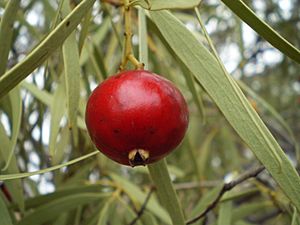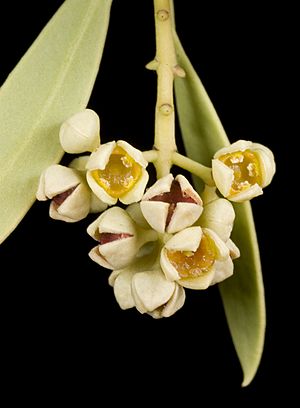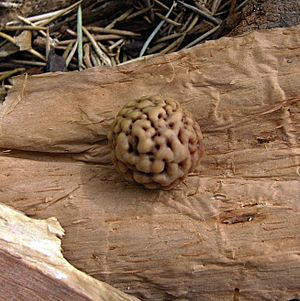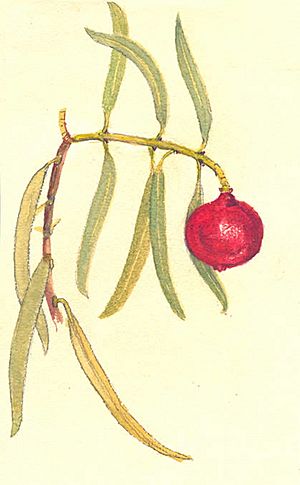Desert quandong facts for kids
Quick facts for kids Desert quandong |
|
|---|---|
 |
|
 |
|
| Scientific classification | |
| Genus: |
Santalum
|
| Species: |
acuminatum
|
The desert quandong (scientific name: Santalum acuminatum) is a unique plant found across central and southern Australia. It belongs to the sandalwood family. People often call it quandong or native peach because of its tasty fruit. This fruit is a well-known bush tucker (traditional Australian food) and has become popular as an exotic flavor. Because of this, people have tried to grow quandongs on farms.
The desert quandong is an evergreen tree, meaning it keeps its leaves all year round. Its fruit can be cooked to make fillings for pies or turned into a juice. The hard seed inside the fruit can be crushed into a paste. This paste was traditionally used to help with sore gums or mouth pain. In places like far-west New South Wales, the quandong is one of the few fruit trees that can handle dry weather. Many Aboriginal communities and local Australians enjoy growing this special fruit.
What Does the Quandong Look Like?
The Santalum acuminatum grows as a tall bush or a small tree. It usually reaches about 4 to 6 meters (13 to 20 feet) high and 2 to 4 meters (7 to 13 feet) wide. Its bark is rough and dark grey. Sometimes, smaller plants sprout from the roots around a bigger tree.
Leaves and Flowers
The leaves are pale yellowish-green and look a bit grey and leathery. They are pointed at the end and grow in pairs along the branches. Each leaf is about 45 to 115 mm (1.8 to 4.5 inches) long.
The flowers are small, only about 2 to 3 mm (0.08 to 0.12 inches) across. They can be green or creamy white on the outside, and reddish or yellowish-brown inside. They also have a nice smell.
Fruit
The quandong tree starts to produce fruit after about four years. The fruit is usually red, but sometimes yellow. It is round and measures between 20 and 40 mm (0.8 to 1.6 inches) across. The skin of the fruit feels waxy. Inside, there's a 3 mm (0.12 inch) layer of tasty flesh covering a hard, brain-like nut. This type of fruit is called a drupe. It ripens from green to a shiny red in late spring or summer.
Special Roots
The quandong has special roots that can reach out up to 10 meters (33 feet) to connect to the roots of other plants. This is because the quandong is a hemiparasitic plant. This means it can make its own food using sunlight (like most plants), but it also gets some water and nutrients from other plants.
Names and History
The desert quandong shares its common name, quandong, with other plants that have similar fruits. To tell them apart, people sometimes call it "desert quandong" or "sweet quandong." In stores, "quandong" usually means the fruit of S. acuminatum. Other names include "native peach."
Indigenous Names
Many different Aboriginal language groups knew this plant. The Wiradjuri people of New South Wales called it guwandhang, which is where the name quandong comes from. Other names include wolgol (by the Noongar people in Western Australia) and wanjanu or mangata (by the Pitjantjatjara people near Uluru).
Scientific Naming
The first scientist to describe this plant was Robert Brown in 1810. He named it Fusanus acuminatus. Later, in 1857, Alphonse Pyrame de Candolle gave it its current name, Santalum acuminatum, placing it in the same group as other sandalwood trees. The word acuminatus means "sharpened" or "pointed," referring to the shape of its leaves.
Where Does the Quandong Grow?
The Santalum acuminatum is found across most southern parts of mainland Australia, even in the dry central areas. In some places, it is quite common. It grows in Western Australia, reaching north to Carnarvon and Karratha. It is also found throughout Southwest Australia.
You can also find the plant in South Australia, Victoria, New South Wales, and Queensland. It is widespread in western New South Wales. Sometimes, groups of quandong plants are found far apart from each other. This happens because the seeds are spread by animals like emus, and also because the climate has changed over a long time.
How Quandongs Live (Ecology)
As a hemiparasitic plant, the quandong can make its own food through photosynthesis. However, it also uses its roots to connect to the roots of other plants. This helps it get extra nutrients like nitrogen and water. The quandong's roots have special pads that wrap around the host plant's roots without harming them. It can connect to many different types of plants, including other trees, grasses, and even other parasitic plants. This way, the quandong can get up to 70% of its nitrogen and some of its water from its hosts.
Habitat and Survival
The quandong grows in many different places, such as creek beds, rocky areas, gravel plains, and sandy dunes. It can handle dry weather, salty soil, and very hot temperatures. It doesn't need soil that is rich in nutrients. Young quandong plants often start growing in the shade of their host plants. As they grow, they reach for the full sun.
Bushfires and Regeneration
Areas where quandongs grow often have bushfires. Because of this, the quandong has learned to grow back from its roots after a fire. This means you rarely see very old, tall quandong trees in areas with frequent fires. Instead, they often grow as sprawling, multi-stemmed bushes. This ability to regrow from roots gives quandongs an advantage over other plants that have to start from seed after a fire.
Animals and Quandongs
Emus love to eat quandong fruit. The hard nut inside the fruit passes through the emu's digestive system unharmed and is dropped in their waste. This is how quandong seeds are usually spread to new places.
Other creatures also interact with the quandong. For example, the quandong moth (Paraepermenia santaliella) feeds on the plant. Larvae of certain beetles and the wood white butterfly also eat quandong parts.
Growing Quandongs

The fruit and nut of the quandong were very important foods for Aboriginal peoples in dry parts of Australia. The fruit is especially rich in vitamin C. Today, quandongs are grown and sold as a bush food. They are sometimes made into jam, a practice that started in the 1970s. Quandongs are known as an exotic food around the world.
Challenges in Growing
At first, growing quandongs was difficult because people didn't fully understand how they lived in nature. Now, growers have learned more about their needs, like well-drained soil and how to help the seeds sprout. They also choose the right host plants. Seeds can take a long time to sprout, sometimes 12 to 18 months. Growers have found more success by placing seeds in mulch from host plants.
Quandongs can also get sick from pests and fungi. However, nurseries have found ways to treat these problems, especially if the soil isn't well-drained.
Farms and Research
One of the first people to successfully grow quandongs on a farm was Brian Powell in South Australia. His successful plants are now considered "Significant Trees." The CSIRO (a big Australian science group) also started supporting quandong research in the 1970s.
Scientists are still researching how to grow quandongs in large orchards. For example, they found that if quandongs grow with a host plant called Melia azedarach (white cedar), the quandong fruit can get natural insect-fighting chemicals. However, they also learned that some harmful substances from host plants can pass into the fruit, so they need to be careful about which host plants are used for food production.
Harvesting Quandongs
Quandong fruit and nuts are collected from the trees or sometimes the nuts are gathered from emu droppings. Most quandongs sold today are still collected from wild trees. When there is good rainfall, the plants produce lots of fruit. Aboriginal people used to dry the fruit and store it for up to eight years.
Since the 1970s, experimental farms have helped increase the supply of quandongs to the market. These farmed fruits can be protected from pests and meet food safety rules. A quandong tree can produce 10 to 25 kg (22 to 55 pounds) of fruit. About 40% of the fruit's weight is the kernel (the nut inside). The kernel can be eaten raw or roasted and salted.
How Quandongs Are Used
For Food

Quandong fruit is used in both sweet and savory dishes. It has a tart flavor, a bit like peach, apricot, or rhubarb. In South Australia, it's sometimes called "wild peach" or "desert peach."
The fruit and nut of the quandong have even been featured on a series of stamps by Australia Post. It's a popular exotic food in other countries, sometimes more so than in Australia itself. The fruit also has special properties that can help protect your body's cells.
Many Aboriginal peoples used the fruit, but they mainly gathered the nuts. The nuts are easy to find undigested in emu droppings. Food safety groups have studied the quandong kernel and found it to be very high in healthy fats.
For Medicine
Aboriginal peoples used the fruit (which has vitamin C) and the kernel (which has special oils) for health. The wood of quandong trees, like all sandalwood species, has qualities that fight bacteria, especially in the roots. Extracts from the plant were used to help heal skin problems. Scientists are still researching how to use these medicinal substances.
For Fuel
The quandong seed is very oily and can burn like a candlenut. It can be used to make light. The wood is also oily, making it good for starting fires with a friction stick.
For Timber
The quandong's wood is hard and oily. Local craftspeople use it to make furniture and cabinets, but it's not widely used. It's strong and lasting, but it doesn't have the strong, pleasant smell of other sandalwood types. The hard, wrinkled nuts have also been used to make necklaces, shirt buttons, and even marbles for games.
Quandong History and People
The oil from sandalwood trees, especially Santalum album, was studied by scientists for its properties. Another Australian sandalwood, Santalum spicatum, was harvested so much for export that the desert quandong (S. acuminatum) became more common in many areas.
Early European settlers in Australia learned about the quandong fruit from Aboriginal peoples. They started making jam and chutney from it. The fruit is often mentioned in old books about nature and plants. However, the kernel (nut) of the seed has historically been used the most.
For a long time, people in Australia didn't try to grow native plants on farms, even if they knew about them. But the high demand for quandongs from places like Singapore and Britain led to people supporting growers. For example, Dudley and Lyla Frahn in Paringa, South Australia, had a quandong orchard. They kept records of their fruit's quality and how much they produced. One of their trees became the source for a special type of quandong called 'Frahn's Paringa Gold', which is now grown and sold.
Images for kids
See also
 In Spanish: Quandong del Desierto para niños
In Spanish: Quandong del Desierto para niños




